Vahid Noroozi
Scaling Test-Time Compute to Achieve IOI Gold Medal with Open-Weight Models
Oct 16, 2025

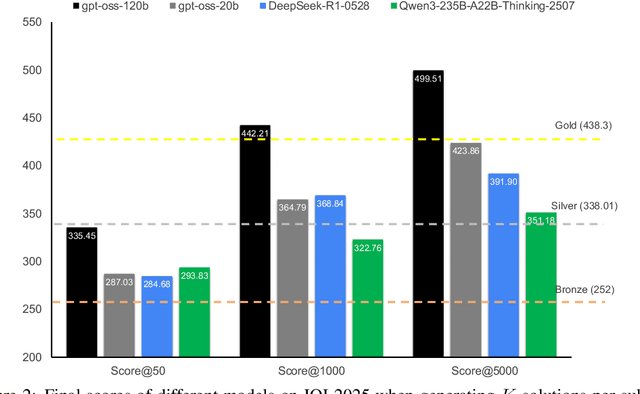

Abstract:Competitive programming has become a rigorous benchmark for evaluating the reasoning and problem-solving capabilities of large language models (LLMs). The International Olympiad in Informatics (IOI) stands out as one of the most prestigious annual competitions in competitive programming and has become a key benchmark for comparing human and AI-level programming ability. While several proprietary models have been claimed to achieve gold medal-level performance at the IOI, often with undisclosed methods, achieving comparable results with open-weight models remains a significant challenge. In this paper, we present \gencluster, a scalable and reproducible test-time compute framework that attains IOI gold-level performance using open-weight models. It combines large-scale generation, behavioral clustering, ranking, and a round-robin submission strategy to efficiently explore diverse solution spaces under limited validation budgets. Our experiments show that the performance of our proposed approach scales consistently with available compute, narrowing the gap between open and closed systems. Notably, we will show that GenCluster can achieve a gold medal at IOI 2025 for the first time with an open-weight model gpt-oss-120b, setting a new benchmark for transparent and reproducible evaluation of reasoning in LLMs.
NVIDIA Nemotron Nano 2: An Accurate and Efficient Hybrid Mamba-Transformer Reasoning Model
Aug 21, 2025



Abstract:We introduce Nemotron-Nano-9B-v2, a hybrid Mamba-Transformer language model designed to increase throughput for reasoning workloads while achieving state-of-the-art accuracy compared to similarly-sized models. Nemotron-Nano-9B-v2 builds on the Nemotron-H architecture, in which the majority of the self-attention layers in the common Transformer architecture are replaced with Mamba-2 layers, to achieve improved inference speed when generating the long thinking traces needed for reasoning. We create Nemotron-Nano-9B-v2 by first pre-training a 12-billion-parameter model (Nemotron-Nano-12B-v2-Base) on 20 trillion tokens using an FP8 training recipe. After aligning Nemotron-Nano-12B-v2-Base, we employ the Minitron strategy to compress and distill the model with the goal of enabling inference on up to 128k tokens on a single NVIDIA A10G GPU (22GiB of memory, bfloat16 precision). Compared to existing similarly-sized models (e.g., Qwen3-8B), we show that Nemotron-Nano-9B-v2 achieves on-par or better accuracy on reasoning benchmarks while achieving up to 6x higher inference throughput in reasoning settings like 8k input and 16k output tokens. We are releasing Nemotron-Nano-9B-v2, Nemotron-Nano12B-v2-Base, and Nemotron-Nano-9B-v2-Base checkpoints along with the majority of our pre- and post-training datasets on Hugging Face.
Llama-Nemotron: Efficient Reasoning Models
May 02, 2025Abstract:We introduce the Llama-Nemotron series of models, an open family of heterogeneous reasoning models that deliver exceptional reasoning capabilities, inference efficiency, and an open license for enterprise use. The family comes in three sizes -- Nano (8B), Super (49B), and Ultra (253B) -- and performs competitively with state-of-the-art reasoning models such as DeepSeek-R1 while offering superior inference throughput and memory efficiency. In this report, we discuss the training procedure for these models, which entails using neural architecture search from Llama 3 models for accelerated inference, knowledge distillation, and continued pretraining, followed by a reasoning-focused post-training stage consisting of two main parts: supervised fine-tuning and large scale reinforcement learning. Llama-Nemotron models are the first open-source models to support a dynamic reasoning toggle, allowing users to switch between standard chat and reasoning modes during inference. To further support open research and facilitate model development, we provide the following resources: 1. We release the Llama-Nemotron reasoning models -- LN-Nano, LN-Super, and LN-Ultra -- under the commercially permissive NVIDIA Open Model License Agreement. 2. We release the complete post-training dataset: Llama-Nemotron-Post-Training-Dataset. 3. We also release our training codebases: NeMo, NeMo-Aligner, and Megatron-LM.
Nemotron-H: A Family of Accurate and Efficient Hybrid Mamba-Transformer Models
Apr 10, 2025

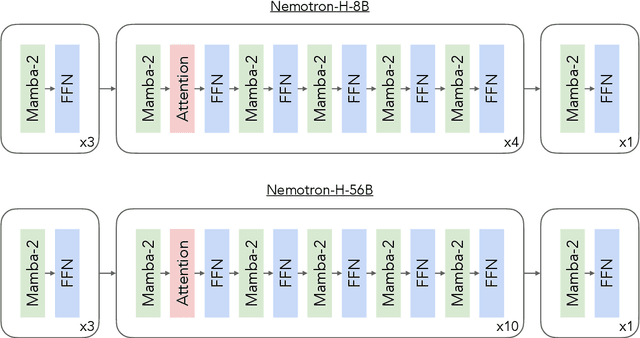
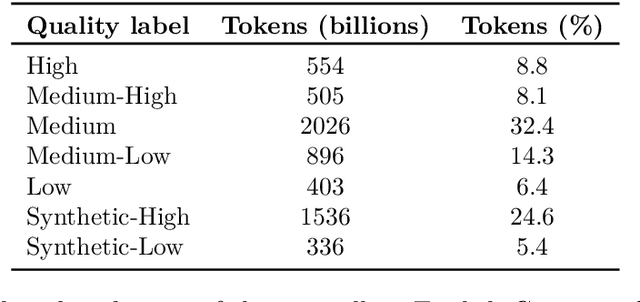
Abstract:As inference-time scaling becomes critical for enhanced reasoning capabilities, it is increasingly becoming important to build models that are efficient to infer. We introduce Nemotron-H, a family of 8B and 56B/47B hybrid Mamba-Transformer models designed to reduce inference cost for a given accuracy level. To achieve this goal, we replace the majority of self-attention layers in the common Transformer model architecture with Mamba layers that perform constant computation and require constant memory per generated token. We show that Nemotron-H models offer either better or on-par accuracy compared to other similarly-sized state-of-the-art open-sourced Transformer models (e.g., Qwen-2.5-7B/72B and Llama-3.1-8B/70B), while being up to 3$\times$ faster at inference. To further increase inference speed and reduce the memory required at inference time, we created Nemotron-H-47B-Base from the 56B model using a new compression via pruning and distillation technique called MiniPuzzle. Nemotron-H-47B-Base achieves similar accuracy to the 56B model, but is 20% faster to infer. In addition, we introduce an FP8-based training recipe and show that it can achieve on par results with BF16-based training. This recipe is used to train the 56B model. All Nemotron-H models will be released, with support in Hugging Face, NeMo, and Megatron-LM.
OpenCodeInstruct: A Large-scale Instruction Tuning Dataset for Code LLMs
Apr 05, 2025Abstract:Large Language Models (LLMs) have transformed software development by enabling code generation, automated debugging, and complex reasoning. However, their continued advancement is constrained by the scarcity of high-quality, publicly available supervised fine-tuning (SFT) datasets tailored for coding tasks. To bridge this gap, we introduce OpenCodeInstruct, the largest open-access instruction tuning dataset, comprising 5 million diverse samples. Each sample includes a programming question, solution, test cases, execution feedback, and LLM-generated quality assessments. We fine-tune various base models, including LLaMA and Qwen, across multiple scales (1B+, 3B+, and 7B+) using our dataset. Comprehensive evaluations on popular benchmarks (HumanEval, MBPP, LiveCodeBench, and BigCodeBench) demonstrate substantial performance improvements achieved by SFT with OpenCodeInstruct. We also present a detailed methodology encompassing seed data curation, synthetic instruction and solution generation, and filtering.
OpenCodeReasoning: Advancing Data Distillation for Competitive Coding
Apr 02, 2025Abstract:Since the advent of reasoning-based large language models, many have found great success from distilling reasoning capabilities into student models. Such techniques have significantly bridged the gap between reasoning and standard LLMs on coding tasks. Despite this, much of the progress on distilling reasoning models remains locked behind proprietary datasets or lacks details on data curation, filtering and subsequent training. To address this, we construct a superior supervised fine-tuning (SFT) dataset that we use to achieve state-of-the-art coding capability results in models of various sizes. Our distilled models use only SFT to achieve 61.8% on LiveCodeBench and 24.6% on CodeContests, surpassing alternatives trained with reinforcement learning. We then perform analysis on the data sources used to construct our dataset, the impact of code execution filtering, and the importance of instruction/solution diversity. We observe that execution filtering negatively affected benchmark accuracy, leading us to prioritize instruction diversity over solution correctness. Finally, we also analyze the token efficiency and reasoning patterns utilized by these models. We will open-source these datasets and distilled models to the community.
Scoring Verifiers: Evaluating Synthetic Verification in Code and Reasoning
Feb 19, 2025Abstract:Code verification has recently found great success as a critical component in training large scale reasoning models for coding. Synthetic techniques such as self-generated test cases and reward models provide a way to enhance code capabilities beyond predefined tests. Building on these advancements, we propose new benchmarks designed to systematically evaluate the impact of synthetic verification methods on assessing solution correctness. We introduce HE-R, HE-R+, MBPP-R, and MBPP-R+, which transform existing coding benchmarks into scoring and ranking datasets to evaluate the effectiveness of synthetic verifiers. Using these benchmarks, we analyze synthetic verification methods in standard, reasoning-based, and reward-based LLMs. Our results show that recent reasoning models significantly improve test case generation and that scaling test cases enhances verification accuracy.
Dynamic-SUPERB Phase-2: A Collaboratively Expanding Benchmark for Measuring the Capabilities of Spoken Language Models with 180 Tasks
Nov 08, 2024



Abstract:Multimodal foundation models, such as Gemini and ChatGPT, have revolutionized human-machine interactions by seamlessly integrating various forms of data. Developing a universal spoken language model that comprehends a wide range of natural language instructions is critical for bridging communication gaps and facilitating more intuitive interactions. However, the absence of a comprehensive evaluation benchmark poses a significant challenge. We present Dynamic-SUPERB Phase-2, an open and evolving benchmark for the comprehensive evaluation of instruction-based universal speech models. Building upon the first generation, this second version incorporates 125 new tasks contributed collaboratively by the global research community, expanding the benchmark to a total of 180 tasks, making it the largest benchmark for speech and audio evaluation. While the first generation of Dynamic-SUPERB was limited to classification tasks, Dynamic-SUPERB Phase-2 broadens its evaluation capabilities by introducing a wide array of novel and diverse tasks, including regression and sequence generation, across speech, music, and environmental audio. Evaluation results indicate that none of the models performed well universally. SALMONN-13B excelled in English ASR, while WavLLM demonstrated high accuracy in emotion recognition, but current models still require further innovations to handle a broader range of tasks. We will soon open-source all task data and the evaluation pipeline.
Genetic Instruct: Scaling up Synthetic Generation of Coding Instructions for Large Language Models
Jul 29, 2024
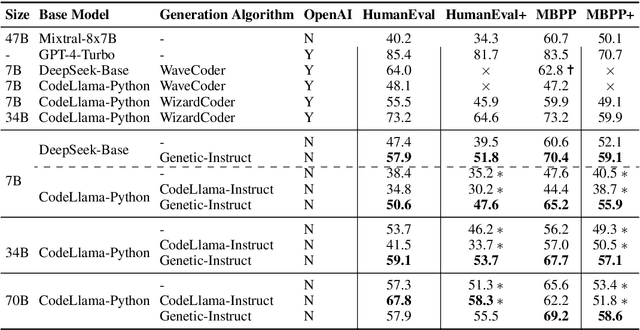
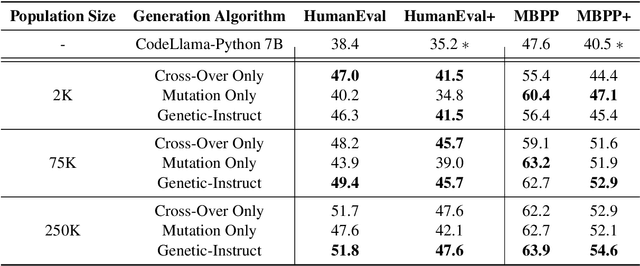
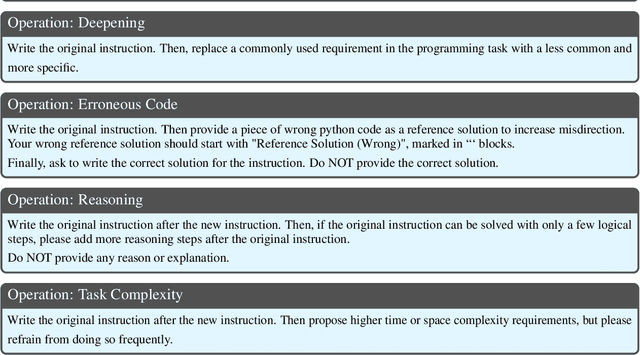
Abstract:Large Language Models (LLMs) rely on instruction samples for alignment, but creating these datasets poses challenges, particularly in expert-dependent tasks like coding, which can be cost-prohibitive. One approach to mitigate these challenges is synthesizing data using another LLM. In this paper, we introduce a scalable method for generating synthetic instructions to enhance the code generation capability of LLMs. The proposed algorithm, Genetic-Instruct, mimics evolutionary processes, utilizing self-instruction to create numerous synthetic samples from a limited number of seeds. Genetic-Instruct is designed for efficient scaling of the generation process. Fine-tuning multiple coding LLMs with the synthetic samples demonstrates a significant improvement in their code generation accuracy compared to the baselines.
Instruction Data Generation and Unsupervised Adaptation for Speech Language Models
Jun 18, 2024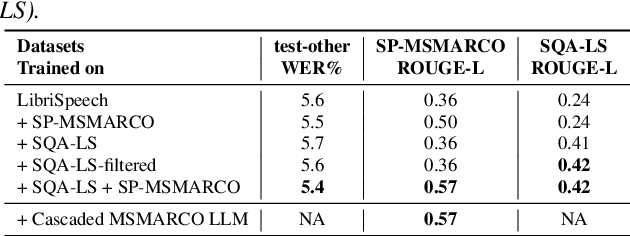
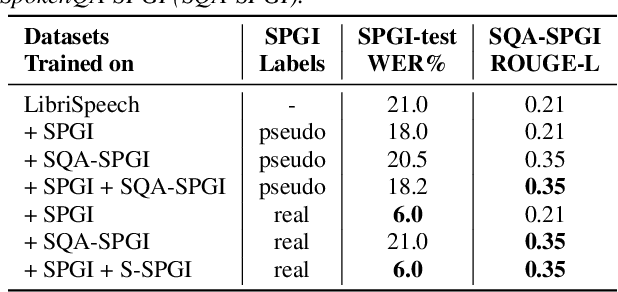
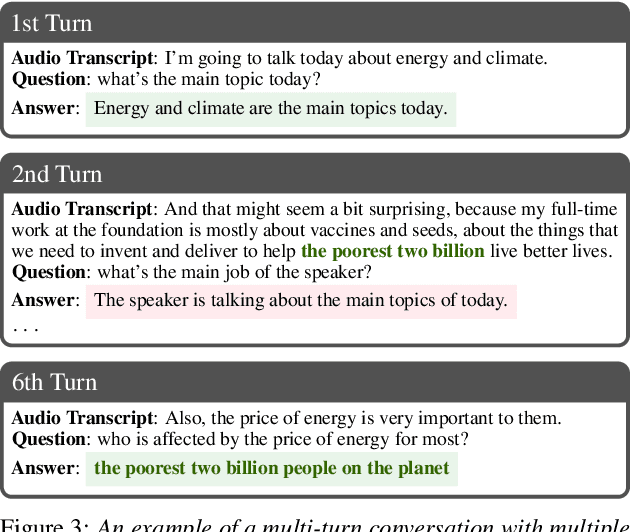
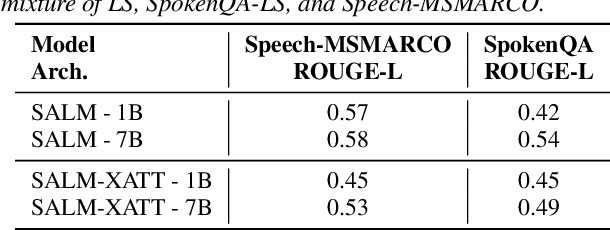
Abstract:In this paper, we propose three methods for generating synthetic samples to train and evaluate multimodal large language models capable of processing both text and speech inputs. Addressing the scarcity of samples containing both modalities, synthetic data generation emerges as a crucial strategy to enhance the performance of such systems and facilitate the modeling of cross-modal relationships between the speech and text domains. Our process employs large language models to generate textual components and text-to-speech systems to generate speech components. The proposed methods offer a practical and effective means to expand the training dataset for these models. Experimental results show progress in achieving an integrated understanding of text and speech. We also highlight the potential of using unlabeled speech data to generate synthetic samples comparable in quality to those with available transcriptions, enabling the expansion of these models to more languages.
 Add to Chrome
Add to Chrome Add to Firefox
Add to Firefox Add to Edge
Add to Edge